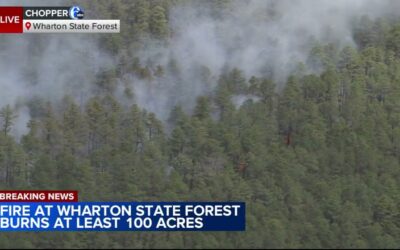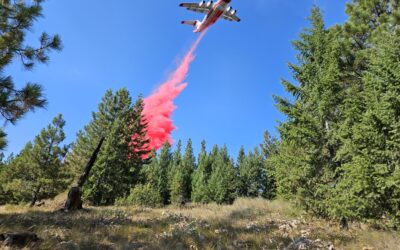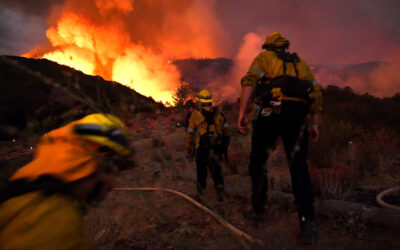Hannah Kanik – Bay Area News Group
Artificial Intelligence can do everything from writing your grocery lists to creating websites, but can it prevent catastrophic wildfires?
Over the past three years, California has seen more than 7 million acres burned from wildfires, and officials across the state are deploying cutting-edge, innovative ways to prevent further devastation by getting to fires before they spread.
In Santa Clara County, officials are installing AI-enabled sensors that measure air particles and temperatures to detect where a small wildfire may be burning out of sight before it grows into an out-of-control blaze.
Ten of these iPad-sized sensors already sit in the hills east of Oakland and are part of a 24-month pilot program out of the Oakland Fire Department. Cal Fire is piloting 400 “ultra-early” sensors from German startup Dryad Networks in Fort Bragg as well.
These sensors “cover more ground broadly, and can spot fires sooner and earlier, particularly in the smoldering phases of fire right when there isn’t even a visible flame,” said Seth Schalet, CEO of the Santa Clara County FireSafe Council. “The sooner and faster you can detect the fire, the quicker you can get to put it out, obviously resulting in less damages to structure, people and the environment.”
The Saratoga-based FireSafe Council is working with San Jose Water to install these sensors across 6,000 acres in the San Jose watershed, across several local communities, in an effort to protect the water source for millions of Santa Clara County residents. As a safety measure, they are not revealing their exact locations.
The solar-powered sensors, which come from the technology company N5 Sensors, measure gas, particulate matter and heat. AI then analyzes that data to detect where small fires may be before they spread.
These data also make their way to an interactive dashboard to provide visualization of the sensor data and fire alerts.
“What we do that’s unique is we combined multimodal sensors. So we’ve got gas and chemicals, heat particulates, all in there coupled with AI, and that lets us identify when there is a fire nearby versus when there’s just better air quality because there might be a fire 50 or 100 miles away,” said Debra Deininger, chief revenue officer of N5 Sensors.
Tech commentators have compared AI to fire itself – a revolutionary tool that can also be dangerous and cause unthinkable damage. Deininger said safety concerns had to be a top priority when designing the sensors.
“We’ve got a number of safeguards in place, in terms of the construction of the very heavy duty case, the design of the battery circuitry, the design of the sensor circuitry–all of that is designed with multiple failsafes in place to automatically shut it down if anything goes awry,” she said.
The type of AI used in the sensors is not as new as ChatGPT and script-writing technology. It uses machine learning to interpret patterns in the deluge of data collected from the sensors.
N5 Sensors, which was funded by the US Department of Homeland Security and has worked with NASA, launched its sensors at the end of last year. They are operating in nine states across the country, as well as Canada.
The San Jose watershed area is scheduled to get its sensors installed in the next two to three weeks, Deininger said.
Related Articles
Technology | Map: Smith River wildfire evacuation, amid countywide power outage
Technology | Smoke from Northern California wildfires could reach North Bay by Sunday afternoon
Technology | Lone Pine Fire 5% contained, more resources sent to address steep Northern California terrain
Technology | Map: Head Fire evacuation zone expands toward Interstate 5
Technology | Map: The 4 areas where Californians are being evacuated because of wildfires
While there’s no silver bullet for managing wildfire risk, sensors like N5’s are part of a growing tool kit officials are using to prevent fires. Satellite imaging and cameras are already in use, and Schalet said he has plans to bring in even more cutting-edge technology, like PanoAI wildfire cameras and Dryad Networks sensors, through partnerships with cities and utilities.
The hope is that early detection will allow firefighters to extinguish blazes before they spread and do major damage. In 1991, a wildfire that ripped through Oakland killed 25 people and cost an estimated $3.9 billion in present-day dollars in damages. Since then, there have been dozens of major fires across the Bay Area.
In 2020, the SCU and CZU Lightning Complex fires burned nearly 400,000 acres of land across five Bay Area counties and destroyed more than 100 structures, and the LNU Lightning Complex Fire overtook 375,209 acres in the North Bay.
Wildfires can also threaten the water supply, and the air pollution they cause can do damage over time.
“A big part of this is insurance, sustainability and protection of that supply,” said Jared Lewis, manager of environmental planning and natural resources at San Jose Water. “The watershed is also in close proximity to a number of communities that are at risk, so there’s the community protection component that’s also important for us.”
Related Articles
Technology | Map: Smith River wildfire evacuation, amid countywide power outage
Technology | Smoke from Northern California wildfires could reach North Bay by Sunday afternoon
Technology | Lone Pine Fire 5% contained, more resources sent to address steep Northern California terrain
Technology | Map: Head Fire evacuation zone expands toward Interstate 5
Technology | Map: The 4 areas where Californians are being evacuated because of wildfires
Schalet said he will present the FireSafe Council’s early wildfire detection and mitigation solutions at the annual Cupertino Public Safety Forum on Thursday, Oct. 19 at 5 p.m.
©2023 MediaNews Group, Inc. Visit at mercurynews.com. Distributed by Tribune Content Agency, LLC.




